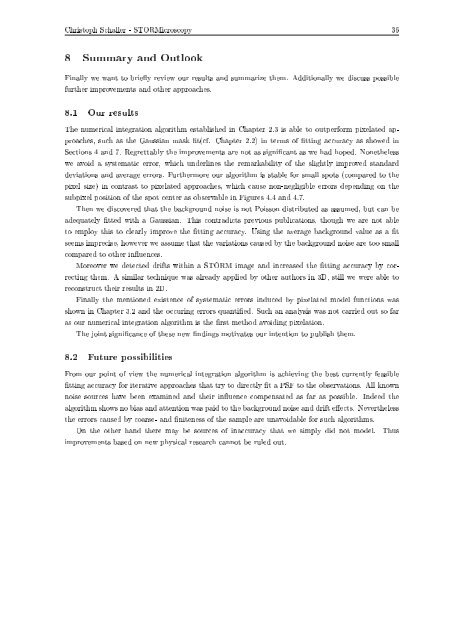Christoph Florian Schaller - FU Berlin, FB MI
Christoph Florian Schaller - FU Berlin, FB MI
Christoph Florian Schaller - FU Berlin, FB MI
Create successful ePaper yourself
Turn your PDF publications into a flip-book with our unique Google optimized e-Paper software.
<strong>Christoph</strong> <strong>Schaller</strong> - STORMicroscopy 36<br />
8 Summary and Outlook<br />
Finally we want to briey review our results and summarize them. Additionally we discuss possible<br />
further improvements and other approaches.<br />
8.1 Our results<br />
The numerical integration algorithm established in Chapter 2.3 is able to outperform pixelated approaches,<br />
such as the Gaussian mask t(cf. Chapter 2.2) in terms of tting accuracy as showed in<br />
Sections 4 and 7. Regrettably the improvements are not as signicant as we had hoped. Nonetheless<br />
we avoid a systematic error, which underlines the remarkability of the slightly improved standard<br />
deviations and average errors. Furthermore our algorithm is stable for small spots (compared to the<br />
pixel size) in contrast to pixelated approaches, which cause non-negligible errors depending on the<br />
subpixel position of the spot center as observable in Figures 4.4 and 4.7.<br />
Then we discovered that the background noise is not Poisson distributed as assumed, but can be<br />
adequately tted with a Gaussian. This contradicts previous publications, though we are not able<br />
to employ this to clearly improve the tting accuracy. Using the average background value as a t<br />
seems imprecise, however we assume that the variations caused by the background noise are too small<br />
compared to other inuences.<br />
Moreover we detected drifts within a STORM image and increased the tting accuracy by correcting<br />
them. A similar technique was already applied by other authors in 3D, still we were able to<br />
reconstruct their results in 2D.<br />
Finally the mentioned existence of systematic errors induced by pixelated model functions was<br />
shown in Chapter 3.2 and the occuring errors quantied. Such an analysis was not carried out so far<br />
as our numerical integration algorithm is the rst method avoiding pixelation.<br />
The joint signicance of these new ndings motivates our intention to publish them.<br />
8.2 Future possibilities<br />
From our point of view the numerical integration algorithm is achieving the best currently feasible<br />
tting accuracy for iterative approaches that try to directly t a PSF to the observations. All known<br />
noise sources have been examined and their inuence compensated as far as possible. Indeed the<br />
algorithm shows no bias and attention was paid to the background noise and drift eects. Nevertheless<br />
the errors caused by coarse- and niteness of the sample are unavoidable for such algorithms.<br />
On the other hand there may be sources of inaccuracy that we simply did not model. Thus<br />
improvements based on new physical research cannot be ruled out.









